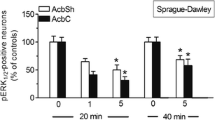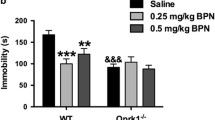Abstract
The aim of this study is to analyze further the opioid receptor subtypes involved in the augmentation of behavioral activity after dopamine depletion in the nucleus accumbens of rats. Initially, the opioid receptors involved in the augmentation of locomotion produced by endogenous opioids were evaluated by microinjection of kelatorphan, an inhibitor of proteolytic enzymes that inactivates enkephalin, with or without specific antagonists forμ 1 orδ-opioid receptors, naloxonazine or naltrindole, respectively. Kelatorphan produced a dose-dependent increase in horizontal photocell counts and vertical movements. At all doses examined the behavioral response was augmented in rats sustaining accumbal dopamine lesions. The augmentation in dopamine-depleted rats was partially blocked by naloxonazine or naltrindole. Since the motor stimulant response to intra-accumbens microinjection of theδ-opioid agonist, [d-penicillamine2,5]-enkephalin, was not augmented in a previous study, we tested the behavioral response to a new endogenousδ-opioid agonist, [d-Ala2] deltorphin I. The locomotor response to deltorphin was slightly augmented in dopamine-depleted rats. These data suggest that the augmentation in the motor response elicited by endogenous opioids after dopamine lesions in the nucleus accumbens involves bothμ 1 andδ-opioid receptors.
Similar content being viewed by others
References
Austin MC, Kalivas PW (1990) Enkephalinergic and GABAergic modulation of motor activity in the ventral pallidum. J Pharmacol Exp Ther 252:1370–1377
Bouboutou R, Waksman G, Devin J, Foiurnie-Zaluski M-C, Roques BP (1984) Bidentate peptides: highly potent new inhibitors of enkephalin degrading enzymes. Life Sci 35:1023–1030
Childers SR (1988) Opiate-inhibited adenylate cyclase in rat brain membranes depleted of Gs-stimulated adenylate cyclase. J Neurochem 50:543–553
Churchill L, Kalivas PW (1992) Dopamine depletion produces augmented behavioral responses to a mu, but not a delta-opioid agonist in the nucleus accumbens: lack of a role for receptor upregulation. Synapse 11:47–57
Churchill L, Austin MC, Kalivas PW (1992) Dopamine and endogenous opioid regulation of picrotoxin-induced locomotion in the ventral pallidum after dopamine depletion in the nucleus accumbens. Psychopharmacology 108:141–146
Clarke PBS, Jakubovic A, Fibiger HC (1988) Anatomical analysis of the involvement of mesolimbocortical dopamine in the locomotor stimulant actions ofd-amphetamine and apomorphine. Psychopharmacology 96:511–520
Cooper DMF, Londos C, Gill DL, Rodbell M (1986) Opiate-receptor-mediated inhibition of adenylate cyclase in rat striatal plasma membranes. J Neurochem 38:1164–1167
Cunningham ST, Kelley AE (1992) Opiate infusion into nucleus accumbens: contrasting effects on motor activity and responding for conditioned reward. Brain Res 588:104–114
Dauge V, Rossignol P, Roques BP (1988) Comparison of the behavioral effects induced by administration in rat nucleus accumbens or nucleus caudatus of selectiveμ andδ opioid peptides or kelatorphan, an inhibitor of enkephalin-degrading enzymes. Psychopharmacology 96:343–352
Delfs JM, Schreiber L, Kelley AE (1990) Microinjection of cocaine into the nucleus accumbens elicits locomotor activation in the rat. J Neurosci 10:303–310
Fallon JH, Moore RY (1978) Catecholamine innervation of basal forebrain. IV. Topography of the dopamine projection to the basal forebrain and striatum. J Comp Neurol 180:545–580
Fink JS, Smith GP (1980) Mesolimbocortical dopamine terminal fields are necessary for normal locomotor and investigatory exploration in rats. Brain Res 199:359–385
Gentleman S, Parenti M, Neff NH, Pert CB (1983) Inhibition of dopamine-activated adenylate cyclase and dopamine binding by opiate receptors in rat striatum. Cell Mol Neurobiol 3:17–26
Gerfen CR, Herkenham M, Thibault J (1987) The neostriatal mosaic: II. Patch- and matrix-directed mesostriatal dopaminergic and non-dopaminergic systems. J Neurosci 7:3915–3934
Jiang Q, Mosberg HI, Porreca F (1990) Antinociceptive effects of [d-Ala2]deltorphin II, a highly selectiveδ agonist in vivo. Life Sci 47:PL43-PL47
Jiang Q, Takemori AE, Sultana M, Portoghese PS, Bowen WD, Mosberg HI, Porreca F (1991) Differential antagonism of opioid delta antinociception by [d-Ala2,Leu5,Cys6]enkephalin and naltrindole 5′-isothiocyanate: evidence for delta receptor subtypes. J Pharmacol Exp Ther 257:1069–1075
Jones DNC, Bowen WD, Portoghese PS, Holtzman SG (1994)δ-Opioid receptor antagonists attenuate motor activity induced by amphetamine but not cocaine. Eur J Pharmacol 249:167–177
Kalivas PW, Bronson M (1985) Mesolimbic dopamine lesions produce an augmented response to enkephalin. Neuropharmacology 24:931–936
Kalivas PW, Widerlov E, Stanley D, Breese GR, Prange AJ Jr (1983) Enkephalin action on the mesolimbic dopamine system: a dopamine-dependent and a dopamine-independent increase in locomotor activity. J Pharmacol Exp Ther 227:229–237
Kalivas PW, Churchill L, Klitenick MA (1993) The circuitry mediating the translation of motivational stimuli into adaptive motor responses. In: Kalivas PW, Barnes CD (eds) Limbic motor circuits and neuropsychiatry. CRC Press, Boca Raton, Fla., pp 237–287
Kelly PH, Iversen SD (1976) Selective 6-OHDA-induced destruction of mesolimbic dopamine neurons: abolition of psychostimulant-induced locomotor activity in rats. Eur J Pharmacol 40:45–56
Koob GF, Stinus L, le Moal M (1981) Hyperactivity and hypoactivity produced by lesions to the mesolimbic dopamine system. Behav Brain Res 3:341–359
Lacey MG, Mercuri NB, North RA (1987) Dopamine acts at D2 receptors to increase potassium conductance in neurones of the rat substantia nigra. J Physiol (Lond) 392:397–416
Law PY, Wu J, Koehler JE, Loh HH (1981) Demonstration and characterization of opiate inhibition of the striatal adenylate cyclase. J Neurochem 36:1834–1846
Le Moine C, Normand E, Guitteny AF, Fouque B, Teoule R, Bloch B (1990) Dopamine receptor gene expression by enkephalin neurons in rat forebrain. Proc Natl Acad Sci USA 87:230–234
Ling G.S.F, Simantov R, Clark JA, Pasternak GW (1986) Naloxonazine actions in vivo. Eur J Pharmacol 129:33–38
Maldonado R, Dauge V, Feger J, Roques BP (1990) Chronic blockade of D2 but not D1 dopamine receptors facilitates behavioral responses to endogenous enkephalins, protected by kelatorphan, administered in the accumbens in rats. Neuropharmacology 29:215–223
Mattia A, Vanderah T, Mosberg HI, Porreca F (1991) Lack of antinociceptive cross-tolerance between [d-Pen2,d-Pen5] enkephalin and [d-Ala2]deltorphin II in mice: evidence for delta receptor subtypes. J Pharmacol Exp Ther 258:583–587
Milliken GA, Johnson DE (1984) Analysis of messy data, vol. I: Designed experiments. Lifetime Learning Publications, Belmont, Calif.
Negri L, Noviello V, Angelucci F (1991) Behavioral effects of deltorphins in rats. Eur J Pharmacol 209:163–168
North RA, Williams JT, Suprenant A, Christie MJ (1987)μ andδ receptors belong to a family of receptors that are coupled to potassium channels. Proc Natl Acad Sci USA 84:5487–5491
Paxinos G, Watson C (1986) The rat brain in stereotaxic coordinates. Academic Press, New York
Pellegrino LK, Pellegrino AS, Cushman AJ (1979) A stereotaxic atlas of the rat brain. Plenum Press, New York
Pert A, Sivit C (1977) Neuroanatomical focus for morphine and enkephalin-induced hypermotility. Nature 265:645–647
Pickel VM, Chan J, Sesack SR (1992) Cellular basis for interactions between catecholaminergic afferents and leu-enkephalin-like immunoreactivity in rat caudate-putamen. J Neurosci Res 31:212–230
Pijnenburg AJJ, Honig WMM, Van der Heyden JAM, Van Rossum JM (1976) Effects of chemical stimulation of the mesolimbic dopamine system upon locomotor activity. Eur J Pharmacol 35:45–58
Porreca F, Takemori AE, Sultana M, Portoghese PS, Bowen WD, Mosberg HI (1992) Modulation of mu-mediated antinociception in the mouse involves opioid delta-2 receptors. J Pharmacol Exp Ther 263:147–152
Raynor K, Kong H, Chen Y, Yasuda K, Yu L, Bell GI, Reisine T (1994) Pharmacological characterization of the clonedκ-,δ-, andμ-opioid receptors. Mol Pharmacol 45:330–334
Sofuoglu M, Portoghese PS, Takemori AE (1991) Differential antagonism of delta opioid agonists by naltrindole and its benzofuran analog (NTB) in mice: evidence for delta opioid receptor subtypes. J Pharmacol Exp Ther 257:676–680
Stevens KE, Mickley GA, McDermott LJ (1986) Brain areas involved in production of morphine-induced locomotor hyperactivity of the C57B1/6J mouse. Pharmacol Biochem Behav 24:1739–1747
Stinus L, Winnock M, Kelley AE (1985) Chronic neuroleptic treatment and mesolimbic dopamine denervation induce behavioral supersensitivity to opiates. Psychopharmacology 85:323–328
Swanson LW (1982) The projections of the ventral tegmental area and adjacent regions: a combined fluorescent retrograde tracer and immunofluorescence study in the rat. Brain Res Bull 9:321–353
Swerdlow NR, Vaccarino FJ, Koob GF (1985) Effects of naloxone on heroin-, amphetamine- and caffeine-stimulated locomotor activity in the rat. Pharmacol Biochem Behav 23:499–501
Tooyama I, Abe H, Renda T, Erspamer V, Kimura H (1993) [d-Ala2] deltorphin I like immunoreactivity in the adult rat brain: immunohistochemical localization. Proc Natl Acad Sci USA 90:9635–9639
Vanderah T, Takemore AE, Sultana M, Portoghese PS, Mosberg HI, Hruby VJ, Haaseth RC, Matsunaga TO, Porreca F (1994) Interaction of [d-Pen2,d-Pen5]enkephalin and [d-Ala2,Glu4]deltorphin withδ-opioid receptor subtypes in vivo. Eur J Pharmacol 252:133–137
Vezina P, Kalivas PW, Stewart J (1987) Sensitization occurs to the locomotor effects of morphine and the specific mu opioid receptor agonist, DAGO, administered repeatedly to the VTA but not to the nucleus accumbens. Brain Res 417:51–58
Waksman G, Bouboutou R, Devin J, Bourgoin S, Cesselin F, Hamon M, Fourni-Zaluski M-C, Roques BP (1985) In vitro and in vivo effects of kelatorphan on enkephalin metabolism in rodent brain. Eur J Pharmacol 117:233–243
Author information
Authors and Affiliations
Rights and permissions
About this article
Cite this article
Churchill, L., Roques, B.P. & Kalivas, P.W. Dopamine depletion augments endogenous opioid-induced locomotion in the nucleus accumbens using bothμ1 andδ opioid receptors. Psychopharmacology 120, 347–355 (1995). https://doi.org/10.1007/BF02311183
Revised:
Issue Date:
DOI: https://doi.org/10.1007/BF02311183




